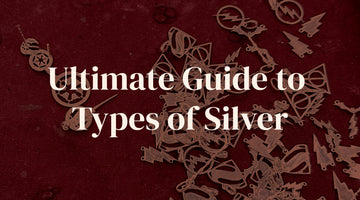Silver has been a go-to for jewelry lovers for centuries, adorning everyone from ancient queens to modern-day trendsetters. Whether you’re a seasoned silver enthusiast or just starting to dip your toes (or fingers) into the world of silver jewelry, knowing the different types of silver is crucial. Not all silver is created equal, and picking the right kind can be the difference between finding a treasure that lasts a lifetime and one that fades away faster than your interest in last year's TikTok trends.
Let’s dive into the dazzling world of silver varieties, where we’ll explore everything from the shiniest sterling silver to the throwback charm of coin silver. And don’t worry, we’ll keep things fun with some pop culture references along the way—because why not make learning about precious metals as entertaining as binge-watching your favorite series?
Also Read: The Ultimate Guide to Types of Diamonds: More Than Just a Girl's Best Friend
Sterling Silver: The All-Star Hero of the Jewelry World
Sterling silver is like the main protagonist in a blockbuster movie—the one everyone roots for. It’s the Tony Stark of metals—strong, reliable, and always looking good. Made up of 92.5% silver and 7.5% other metals (usually copper), sterling silver is what you’ll find in most high-quality jewelry. This mix isn’t just random—it’s designed to give silver the durability it needs to stand up to daily wear without losing its shine.
But why not just use pure silver, you ask? Good question! Pure silver, or fine silver, is a bit like that friend who’s super pretty but also super fragile. It’s 99.9% silver, which makes it softer and more prone to scratches and dents. Sterling silver, on the other hand, is tough enough to withstand the rigors of daily life while still maintaining that unmistakable silver luster.
You’ll know you’re dealing with sterling silver if you spot a “925” stamp on your jewelry. That number is your guarantee that the piece contains 92.5% pure silver. This mark is as iconic in the jewelry world as the Bat-Signal is in Gotham. It’s a sign that you’re getting the real deal—something that can last for years if you take care of it.
And here’s a little secret: Sterling silver can tarnish over time, but it’s nothing to freak out about. Think of it like Wolverine healing from a wound—it might take a little time, but with a bit of polish, your sterling silver will be back to its shiny, indestructible self.
Fine Silver: The Elven Treasure of the Jewelry Kingdom
Imagine the swords and crowns in The Lord of the Rings—all gleaming with an almost otherworldly radiance. Now, imagine if those were made of fine silver. Fine silver is the purest form of silver you can find, with a purity level of 99.9%. It’s like the elven treasures of the jewelry world: pure, beautiful, and delicate.
Because it’s so pure, fine silver is softer than sterling silver, which means it’s more susceptible to scratches and dings. This makes it perfect for pieces that don’t see a lot of rough-and-tumble action—think delicate earrings or necklaces that are more about making a statement than taking a beating.
The purity of fine silver also gives it a unique, almost luminous sheen that you won’t find in other types of silver. It’s the kind of metal that you’d want to save for special occasions—like Bilbo Baggins pulling out his mithril armor for that unexpected journey. It’s beautiful and precious, but not necessarily what you’d want to wear when you’re out battling orcs (or just running errands).
Also Read: Shine Bright Like a Silver: The Ultimate Guide to Silver Jewelry
Argentium Silver: The T-1000 of the Silver World
If you’re a fan of Terminator 2, you’ll remember the T-1000—an advanced, shape-shifting robot made of liquid metal. Argentium silver isn’t quite that futuristic, but it’s pretty close. Argentium is a modern twist on sterling silver, and it’s quickly becoming a favorite among jewelers for its unique properties.
What sets Argentium silver apart is that it replaces some of the copper in the sterling silver alloy with germanium. This small change makes a big difference: Argentium is more resistant to tarnish, meaning it stays shiny longer without needing constant polishing. It’s like having a self-cleaning suit of armor—no maintenance required.
Argentium silver is also stronger and more durable than traditional sterling silver, making it a great choice for jewelry that you plan to wear every day. Plus, it’s hypoallergenic, which is great news for anyone who’s ever had a bad reaction to a piece of jewelry. So, if you’re looking for something that combines the classic beauty of silver with the durability of a sci-fi super metal, Argentium silver might just be your new best friend.
Coin Silver: The Vintage Treasure of the Jewelry World
Ever dreamed of discovering a treasure chest filled with ancient coins, like in Pirates of the Caribbean? Coin silver might just be your buried treasure. Back in the day, coin silver was made by melting down actual silver coins, which gave it a purity level of around 90%. These days, it’s not as common, but it’s still prized by collectors and those who love a bit of history with their bling.
Coin silver is like a vintage comic book—it’s not the latest and greatest, but it has a charm and value that’s all its own. You’ll often find it in antique shops or passed down as heirlooms. It’s not something you’re likely to stumble across at your local mall, but if you’re into unique pieces with a story to tell, coin silver is where it’s at.
Also Read: Shining a Light on Lab-Grown Diamonds: What, How, and Are They Real?
Silver-Plated: The Fast Fashion of Silver
We all love a good deal, but sometimes you get what you pay for. Silver-plated jewelry is the fast fashion of the silver world. It looks great when you first buy it, but it’s not built to last. Silver-plated items have a thin layer of silver coating a base metal like copper or brass. It’s like putting a fancy veneer over something less glamorous underneath.
Silver-plated jewelry is perfect for those trendy pieces you don’t plan to keep forever—think of it like that quirky jacket you bought because it was cool, but you know you’ll only wear it a couple of times. The downside? Over time, the silver plating can wear off, revealing the less-than-shiny metal beneath. So while silver-plated jewelry can be fun and affordable, it’s not something you want to rely on for the long haul.
The Best Quality Silver: Your Jewelry Endgame
So, how do you choose the best quality silver for your jewelry collection? It all depends on what you’re looking for. If you want something that’s beautiful, durable, and versatile, sterling silver is your go-to. It’s the perfect balance of shine and strength, making it ideal for everything from rings to necklaces to bracelets.
If you’re after something a little more luxurious, fine silver offers the highest purity, though it’s best reserved for pieces that won’t take a lot of wear and tear. It’s like the rare collectible in your display case—beautiful to look at, but maybe not something you’d want to use every day.
For those who want the latest and greatest, Argentium silver offers all the benefits of sterling silver with a few high-tech upgrades. It’s more tarnish-resistant, stronger, and hypoallergenic, making it a great choice for modern jewelry lovers who don’t want to compromise on quality.
And if you’re a fan of all things vintage, coin silver offers a bit of history with every piece. It’s not as common, but it’s a great way to add some unique charm to your collection.
Also Read: 7 Common Jewelry Shopping Mistakes and How to Avoid Them
Silver Purity: The Final Word
When it comes to silver purity, it’s all about knowing what you’re buying. The purity of your silver jewelry determines its value, durability, and how well it will hold up over time. Sterling silver, with its 92.5% purity, is the standard for most jewelry, offering a great balance between beauty and strength.
Fine silver, at 99.9% purity, is as pure as it gets, but it’s also softer and more prone to damage. Argentium silver offers a slightly higher purity than traditional sterling silver, along with extra durability and tarnish resistance.
So, the next time you’re shopping for silver jewelry, keep an eye out for those purity stamps and know what they mean. Whether you’re looking for a piece to wear every day or something special for a big event, understanding the different types of silver will help you find the perfect piece to add to your collection.
Conclusion: Your Silver Saga
Whether you’re a silver newbie or a seasoned collector, knowing the different types of silver can make all the difference in finding jewelry that suits your style and lasts for years to come. From the classic appeal of sterling silver to the futuristic shine of Argentium, there’s a silver variety out there for everyone.
So go forth and shine like the silver superstar you are—because in the world of jewelry, knowledge is as valuable as the metal itself. And remember, just like your favorite hero’s journey, the quest for the perfect piece of silver jewelry is all about making informed choices and enjoying the ride. Happy hunting!

